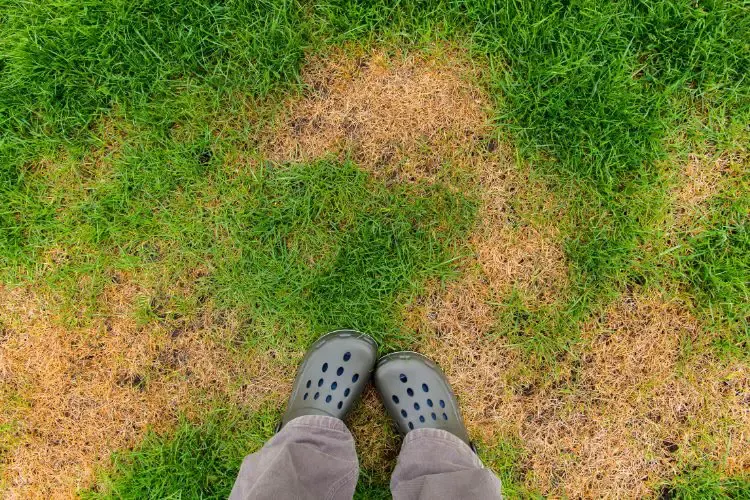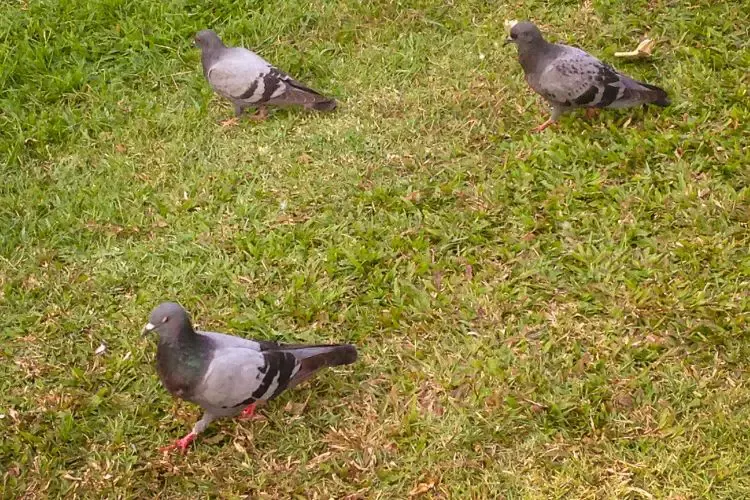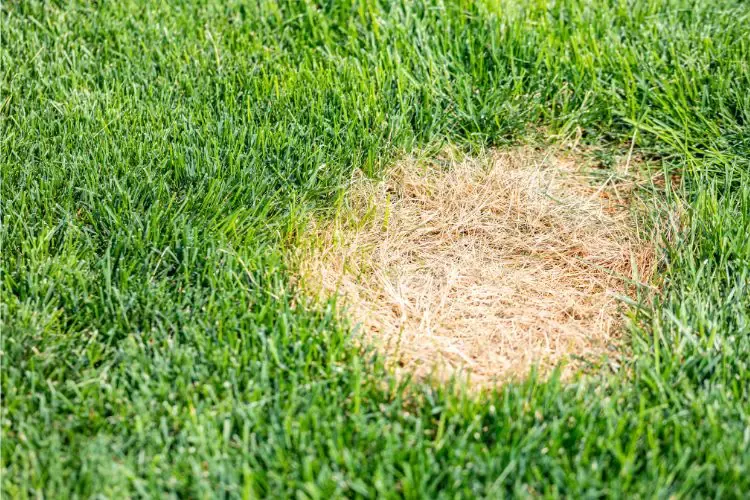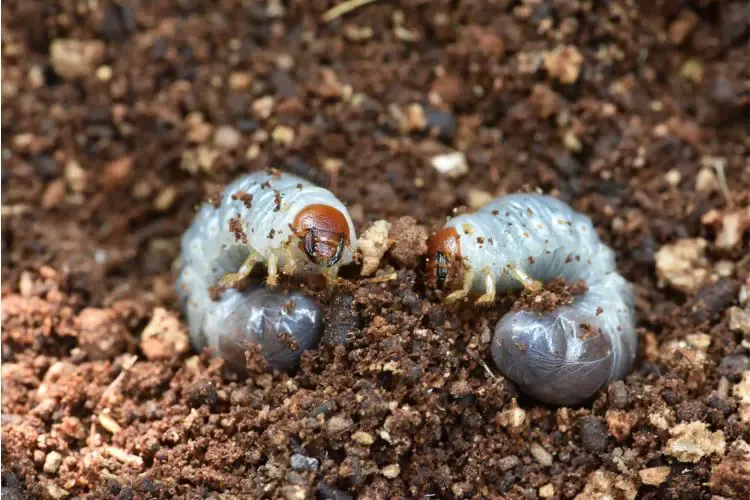Hello, fellow greenery devotees!
Does your once verdant lawn now resemble a worn-out rug?
Before you point fingers at the weather or your new fertilizer, allow me to introduce a possible culprit – grubs!
These little subterranean banqueters are beetle larvae that love nothing more than a good root feast, turning your dreamy greens into a patchwork of woes.
But how do you know if grubs are playing the villain in your lawn story?
Don’t worry, we’re here to turn you into a top-notch grub detective.
Let’s look at the eight signs that scream, “Hey, you’ve got grubs!”.
1. Irregular Brown Patches

Ever looked out your window and noticed your once monochrome green lawn now sports a rather avant-garde pattern of irregular brown patches?
If these patches stay resolute despite your dedicated watering and fertilizing efforts, grubs could be the cause.
As a gourmet of grass roots, these minuscule munchers deprive your lawn of essential nutrients, leading to browning.
Imagine grubs hosting their version of a farm-to-table dinner, except the farm is your lawn and the table is, well, also your lawn.
2. Spongy Lawn
Has your lawn taken on an oddly spongy feel, making your morning strolls feel like you’re bouncing on a garden-sized marshmallow?
Before you start questioning your sanity, this could be another signal that grubs have set up camp.
As they chomp away at the grass roots, the turf becomes loose, leading to that strange spongy sensation.
Suddenly, you’re not just a lawn owner; you’ve become the reluctant landlord of a bustling grub city.
3. Peeling Lawn
If sections of your lawn can be pulled up as easily as lifting a flap of new carpet, you might have a grub issue.
When grubs decimate the grass roots, the grass loses its anchor, making it easily detachable.
It’s as if the grubs have decided to implement an open-floor plan in your lawn, sans your permission.
4. Increased Wildlife Activity

Are birds, raccoons, or skunks treating your lawn like the hottest new restaurant in town?
If you notice an uptick in animal digging, it could be a sign that your lawn is hosting a grub banquet.
Just like us, these animals can’t resist a tasty treat – in their case, grubs!
5. Visible Grubs

If you find C-shaped, white or yellowish creatures in the soil while gardening, it’s time to ring the grub alarm.
These visible grubs are like unwelcome squatters, and they can lay waste to a once thriving lawn.
They might not win any beauty pageants, but they certainly take the cake for being lawn pests.
6. Thin or Bare Spots

Have bare spots popped up on your lawn like unsightly bald patches?
Or has your once thick and robust lawn started looking thin and anaemic?
Grub damage could be behind these bare or thinning areas, as they chew away at the grassroots, causing the grass to die.
It’s as if your lawn is going through a midlife crisis, but the cause is lurking beneath the surface.
7. Wilting Grass
Does your grass look like it’s on a perpetual wilt, despite receiving adequate water and care?
You might have grubs feasting on your lawn’s root system, affecting its ability to absorb water and nutrients.
It’s as if the grubs are hosting a never-ending root fest, and your poor grass is paying the price.
8. Increased Insect Activity
Have beetles suddenly developed a fondness for your property, buzzing around Sign Eight: Increased Insect Activity
Have beetles suddenly developed a fondness for your property, buzzing around more than usual?
Well, these beetles might be more than just pesky intruders.
As the adult form of common lawn grubs, an increase in beetle activity could signify an impending grub infestation.
It’s as if your lawn has become the beetle version of a trendy nursery, with grubs ready to hatch and wreak havoc.
How to Get Rid of Grubs in Your Lawn

Finally found the culprits turning your lawn into a patchy, brown eyesore?
Now that you’ve identified a grub infestation, you’re probably wondering how to send these root-munchers packing.
You’re in luck, because we’re switching gears from grub detection to grub eviction!
First things first, adopting a solid lawn care regimen can go a long way in deterring grubs.
This includes regular watering, mowing at the right height, and choosing the right fertilizer.
Basically, the healthier your lawn, the less attractive it is to grubs – they prefer the neglected, ‘easy pickings’ types.
For those with an already established grub problem, a variety of grub control products are available on the market.
You’ll find both chemical and natural options depending on your preference and the severity of the infestation.
Nematodes, tiny parasitic roundworms, are a popular organic option that targets grubs without harming beneficial insects.
For severe infestations, chemical treatments can be used, but remember to follow the manufacturer’s instructions closely.
Don’t forget that timing is crucial.
Grub treatments are most effective when the grubs are young and actively feeding, usually in late summer or early fall.
However, be prepared – it may take a season or two to control a severe infestation.
Patience is key here – remember, Rome wasn’t built in a day, and a grub-free lawn isn’t either!
Also, don’t hesitate to enlist the help of a lawn care professional if things get out of hand.
They have the expertise and resources to deal with stubborn infestations and can provide you with customized solutions.
Remember, grubs may be mighty munchers, but with the right strategies, you can reclaim your lush, green lawn from their clutches.
Final Thoughts
Well, my green-thumbed friends, we’ve journeyed through the underbelly of your lawn today, unlocking the secrets of those clandestine root-munchers – grubs!
From irregular brown patches to wilting grass, we’ve discovered that these beetle larvae aren’t just unsightly, they’re downright destructive. And let’s not even talk about the impromptu wildlife meet-ups they cause!
But all is not lost. Armed with our grub-locating knowledge and an arsenal of grub-combat strategies, we’re ready to tackle these pesky invaders head-on.
Whether you opt for regular lawn care, natural remedies like nematodes, or calling in the big guns with chemical treatments, remember that patience is a virtue. Grub infestations aren’t built in a day, and they certainly won’t disappear overnight.
And hey, if it all seems like too much, don’t hesitate to call in a pro. There’s no shame in needing a bit of extra help.
In the end, our goal is a simple one: to reclaim our lawns from the grub grip and restore their green glory.
Remember, a lawn is a terrible thing to waste – especially on grubs!
Now, off you go! It’s time to bid those grubs a not-so-fond farewell. Happy gardening, folks!

